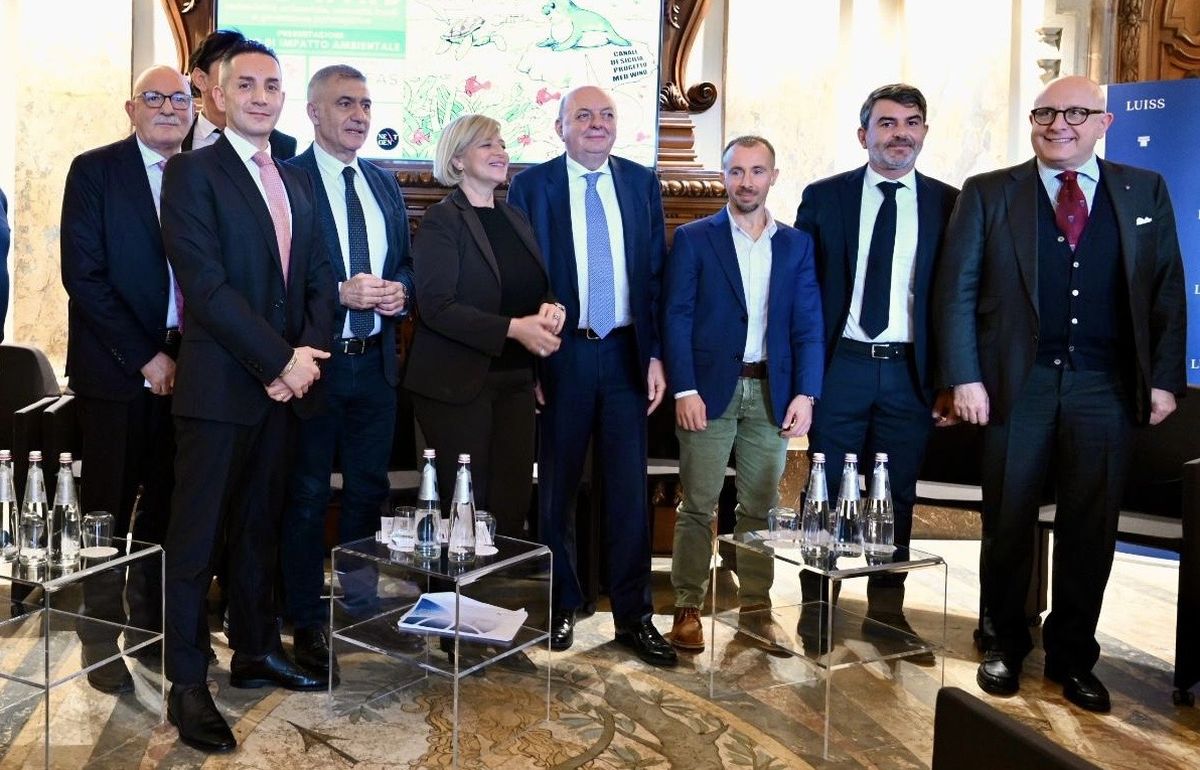ROME (ITALPRESS) – How to make the best use of the potential of renewables while at the same time concretely and ethically respecting the land and marine ecosystems and local communities affected by the projects? Med Wind, the largest floating offshore wind farm project in the Mediterranean, which will rise more than 80 km off the coast of Sicily, off Trapani, is already a model in the development strategies of a just energy transition for Italy. A goal that must be pursued with a systemic vision, promoting environmentally compatible growth and fostering energy democracy in the territories.Thanks to preliminary environmental surveys, conducted with the support of the Navy and with the involvement of the Zoological Station “Anton Dohrn” of Naples, together with geophysical, geotechnical and archaeological investigations, it was possible to identify the area suitable to host the Med Wind floating plant designed by Renexia. The three-dimensional map, elaborated by bathymetric surveys, made it possible to plan, with the utmost care, the positioning of the turbines and thus ensure the protection of the surrounding environment. In addition, thanks to the innovative “floating” technology, the installation of the wind structures does not involve drilling the seabed but employs a mooring system.The data from the Environmental Impact Study, carried out by RINA, were presented at the event “Med Wind: environmental sustainability, local communities and participatory governance,” sponsored by Fondazione UniVerde, Stazione Zoologica “Anton Dohrn” and Renexia, which took place today in Rome at the Sala delle Colonne of Luiss Guido Carli University and live streamed on Radio Radicale, with the event partnership of Seas Geosciences. Media partners: Askanews, Italpress, TeleAmbiente, Opera2030, Canale Energia, Next Gen.Alfonso Pecoraro Scanio (President of the UniVerde Foundation) says, “Ecological and digital transitions are a top priority to address the climate crisis, overcome fossil fuels and pursue the goal of energy independence for Italy. Precisely the careful and sustainable diffusion of offshore wind power can reconcile the need to build plants at sea, far from the coasts, taking the opportunity to create in those areas protected areas that promote the repopulation and recovery of habitats, the conservation of marine biological resources, aiming to respect the biodiversity that populate them, starting with cetaceans and the avifauna that flies over them along their migratory routes. Importantly, the construction of this floating offshore wind farm was preceded by careful scientific validation, ensured by Anton Dohrn researchers. Virtuous choices are the key building block to walk the right energy transition, capable of meeting the needs of resilience and sustainability. We need to show that renewables can be implemented in a way that ensures environmental and social sustainability as well as economic sustainability. “Riccardo Toto (Renexia General Manager) emphasizes, “We are really proud to have illustrated the Environmental Impact Study of our Med Wind project. For Renexia it was a total investment of about 42 million euros, one of the largest ever in this field. It is essential to lay a solid foundation to materialize a 3 GW park like Med Wind that will ensure 3 percent of the national energy demand, avoiding millions of tons of climate-changing emissions. In addition to the environment and energy transition, the positive spin-offs are also framed from an industrial point of view; we are facing the possibility of kick-starting a national industrial supply chain specialized in wind power, also aimed at international markets. The turbine factory we are working on goes precisely in that direction: to create a large Italian wind industry and to grow employment. “For Gilberto Pichetto Fratin (Minister of the Environment and Energy Security) ‘offshore wind is one of the great production strands, also of high quantities of energy, for a country immersed in the Mediterranean with areas of high windiness. Our scenario planning to 2040 entrusts this technology with a key role in meeting the growing demand for energy. We must accompany the path of these great evolving technologies, which can also create the conditions for the full protection of our country’s marine areas and biodiversity. We need to combine innovation and sustainability, combining the protection of biodiversity with the development of renewables. “Tatjana Hema (UNEP / MAP Coordinator, United Nations Environment Program’s Mediterranean Action Plan) emphasized, “The Mediterranean region is moving towards a new era of renewable energy to combat climate change. Marine and offshore wind renewables can have great potential in contributing to this effort. UNEP/MAP is closely exploring future opportunities to ensure that possible negative impacts on the marine and coastal environment are better understood and measures are taken in a timely manner to minimize them. Success depends on strong policies, regional collaboration, and sustainable practices. By embracing innovation and working together, we can create a cleaner and more resilient energy future that safeguards our seas, stimulates economic growth, and ensures a better future for generations to come. “Roberto Danovaro (Professor at the Università Politecnica delle Marche and Chairman of the Scientific Committee of the UniVerde Foundation) recalled that “floating offshore wind represents a unique opportunity for achieving energy security goals for our country. This technology is able to combine low-cost clean energy production with environmental protection. “The report on the investigations for the preparation of the Environmental Impact Study, related to the installation of the floating wind generators of the Med Wind plant, was presented by Silvio Greco (Vice President of the Zoological Station “Anton Dohrn” in Naples) who illustrated the evidence arising from the research campaign, which lasted about 18 months, conducted in the Strait of Sicily. The stretch of sea explored showed researchers unique environments for the abundance and richness of corals, sponges and fish, which is difficult to observe in other parts of the Mediterranean. The special oceanographic conditions of the area allow the lush growth of magnificent underwater forests. In particular, bathymetric surveys, carried out with a sophisticated multibeam echosounder, have made it possible to draw up a detailed three-dimensional map of the seafloor, carrying out the explorations with an underwater robotic vehicle equipped with ultra-high-definition cameras.The research has revealed a largely never-before-observed biota, and some varieties of marine flora and fauna may turn out to be new species. However, marks left over the years by illegal fishing activities that have opened deep wounds on the seafloor, destroying and wiping out a great many corals that had taken thousands of years to grow, are very evident in some stretches of the sea.In addition to the research campaign, the oceanographic campaign lasted about two months, and an additional 12 months of research related to avifauna, cetaceans and marine reptiles. Experimental fishing campaigns and targeted studies on marine litter in the area were also carried out. The investigations conducted involved researchers and technicians from the “Anton Dohrn” Zoological Station in Naples together with colleagues from the Universities of Messina, Palermo, Genoa and the CNR in Capo Granitola, under the scientific coordination of Prof. GrecoIdentifying the ideal positioning of the floating generators, Med Wind’s turbines will be able to be installed offshore, avoiding landscape impacts, in marine sites that do not threaten habitats and migratory routes, at wide exploitation of wind resources to maximize the performance of the offshore park that will ensure an annual production of clean energy of about 8-9 TWh, able to meet the energy needs of 3.4 million households, contributing to reduce CO2 emissions by about 2.7 million tons per year.Paolo Casciotti (President of Seas Geosciences and General Manager of Marine Services Sealaska) explained, “Seas Geosciences shares Renexia’s values and priorities and is pleased to collaborate on the Med Wind project, which, moreover, benefits local communities. Seas’ team of geoscience and subsea engineering experts specializes in working efficiently and safely in deep water to acquire geotechnical information. Our innovative sampling methods with unique, remotely operated systems to study the underwater environment, as well as our ability to work in waters deeper than 900 meters, will enable Renexia to define and design the most appropriate anchoring systems for the turbines and ensure maximum attention to the surrounding ecosystem.” In addition, as part of Woocheen, Seas draws inspiration from the shared heritage of the 26,000 Alaska Native shareholders of Sealaska, whose people have lived in relationship with the land and ocean for 10,000 years. “This connection over millennia informs the company’s focus on ocean health. In addition, Seas’ profits directly support Alaska Native communities with scholarships, economic opportunities, revitalization of indigenous culture and language, and more. “The Environmental Impact Study (EIS), filed with the Ministry of Environment and Energy Safety, was presented by Andrea Giovanetti (RINA Health, Safety and Environment Project Management).The event was opened by a welcome address from Gianfranco Pellegrino (Professor of Political Philosophy at Luiss Guido Carli University) who said, “Sustainability is an ecosystem that needs a balance between different factors and dimensions. Environmental impact studies, such as the one presented today, are important to preserve that balance. In hosting this event, Luiss confirms, once again, its concrete commitment to sustainability, focusing on the need to develop new models to meet the challenges of the energy and ecological transition.”The round table, moderated by Donatella Bianchi (Journalist and TV host), also featured:Roberto Bardari (Commissioner Referent of the Offshore Wind Instructors Group at the PNRR-PNIEC Technical Commission, Ministry of Environment and Energy Security) described “the state of the art on the instances in Environmental Impact Assessment (EIA) and in scoping of offshore wind plants under processing and examinations by the PNRR-PNIEC Technical Commission of the MASE.”Gaetano Armao (President of the Sicilian Region’s Specialized Technical Commission for Environmental Authorizations) reiterated the importance of “focusing on floating marine wind as an opportunity to relieve pressure on land, save on energy bills for the benefit of citizens, and to enable Sicily to increasingly become the renewable energy hub of the Mediterranean. “Giuseppe Onufrio (Director of Greenpeace Italy): “Floating wind represents one of the very few new technologies that can make a relevant contribution to counter the global climate crisis. It is an important industrial development opportunity that, with appropriate planning, can be combined with the reduction of impacts on the marine ecosystem. The project under discussion gives a chance to get this promising technology off on the right foot. “In the implementation of the pioneering project, which will involve a total investment of about 9.3 billion euros with the creation of thousands of new jobs, many of them highly skilled, over the life of the plant, Renexia adopted a model based on inclusion and dialogue with local communities from the outset. From the earliest stages, it was developed with a participatory approach, involving institutions, associations and local stakeholders to ensure maximum transparency and compatibility with the local area. Among the main initiatives promoted was the important collaboration with the fishing sector: in fact, the player activated a technical table with fishermen and trade associations to mitigate the impact of offshore activities and develop long-term programs to support the sector. Through memoranda of understanding with local authorities and trade unions, Med Wind also promotes economic growth and the creation of regional production chains, guaranteeing qualified employment opportunities, not only in the construction phase but also for maintenance activities over the 25 years envisaged by the concession.-photo press office Fondazione Univerde-(ITALPRESS)

